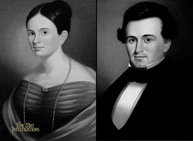Discovering History through Art Historians usually add a painting as an illustration. Fine Art Investigations uses portraits as an entry point to history. An example is the stories behind the recently re-discovered portraits of the Dunnicas. The first part of their biography briefly described American expansion in the west after the War of 1812. Back when the Western frontier was central Missouri and …
Rediscovered Bingham Portraits: The Dunnicas, Part 3
The Correction Introduction This is the third of four blogs about the re-discovered George Caleb Bingham portraits of William Franklin Dunnica and Martha Jane Shackelford Dunnica. The work of E. Maurice Bloch (1925-1989), the world’s acknowledged expert on artist George Caleb Bingham (1811-1879), is awe-inspiring. At the University of California Los Angeles, where he was a professor of art history, he …
Rediscovered Bingham Portraits: The Dunnicas, Part 2
Rediscovered Bingham Portraits: Connoisseurship Introduction Provenance and art historical research strongly suggested that family lore was true: George Caleb Bingham painted the heirloom portraits of William Franklin Dunnica and his wife, Martha Jane Shackelford. (See Rediscovered Bingham Portraits: The Dunnicas, Part 1). Would connoisseurship confirm or deny that the portrait pair were rediscovered paintings by Bingham? Context According to art historical research, Bingham painted …
Recto and Verso: The Dunnicas
Recto – George Caleb Bingham Early Years William Franklin Dunnica was a 30-year-old merchant in Glasgow, Chariton County, Missouri, in 1837 when George Caleb Bingham painted the recently re-discovered portraits of him and of his 17-year-old wife, Martha Jane Shackelford. A year later, the Missouri militia called Dunnica and other men from Chariton County to neighboring Carroll County where long-term …


